Yes, thinking about mud

Mud is the bane of the Bengali middle-class. Yet, mud is all over the place. Mud—that gooey, gluey, brown muck—lies waiting in the dry dust and with a little sprinkling of water rises up in rebellion, and grabs the pumps, heels and sandals of the middle-class and makes them skid off balance.
The whole ground cover of Bangladesh is a blanket of mud, unsuspecting when dry and unforgiving otherwise. The ground under water, in ponds, paddy fields, canals, and wetlands, is mostly mud. In other geographies, it is swamp, bog, peat or fen, that muck we have abandoned as we donned the culture of cities (they literally bog us down, or put us in a quagmire). Salman Rushdie, in Midnight's Children, gives an animated picture of a landscape of "chirring insects and croaking frogs" (he was describing the Sundarbans), where ripened fruits fall on the ground to be devoured by insects, bugs, and other miniscule creatures that throng the moist ground.
Mud's elusive behaviour makes it unreliable to the urbanites. When dry, sans water, mud can be as brittle as biscuits, and crumble like dust at the slightest pressure. As winds whip up over such a terrain, mud floats around as dust. Here is the opening shot of a film that captures the conundrum vividly:
Amulya returns to his home village from the city educated and transformed into a petit babu. His boat glides into the mushy riverbank, and as he steps off the boat, bag and baggage, he slips and falls into the mud full body. A young girl, Mrinmoyee, watching the sad spectacle of the town babu breaks out in laughter. We will soon realise that Amulya falls in love as well. With this mud metaphor, Satyajit Ray's tender and beautiful movie "Samapti" opens up a narrative on that slimy substance as well. Based on Rabindranath Tagore's short story, the narrative is a reverse transformation of a sahib, willing to reconcile with the world of wetness.
Mud and muck are at the crux of development strategies, in what we consider as "cultured", and what we deem to be otherwise. There is nothing glorious about mud. When it clings to us, on our white pants, we immediately rush to clean it off. Advertising agencies are constantly selling detergents that get rid of mud and soil off rambunctious children, as if the slightest strain will mark the fall of society. While some mothers chastise their children for getting mud on their clothes, some mothers and others cake in mud for a more beauteous body. While urban dwelling calls for the banishment of mud from its premise, people in villages still lovingly layer the floors and walls of their houses in a most aesthetical way.
Muddy stuff is at the cosmic beginning of things, yet there is no philosophy of mud. No one has thought deeply about the ubiquity of mud in our progression as humans. Aristotle spoke about a certain "foamy matter" in a primordial world condition that allowed for the generation of new life, but we are not quite sure it is mud.
Borne out of the mixture of water with dirt and soil, mud is transformative, shifting from brittleness to a paste. In the hands of men and women, mud becomes clay, and the substance of Bengal's cultural products for millennia. Baked, mud can become brick and terracotta, and remains the fundamental material source for building edifices, such as cities. When barge loads of brick arrive at the periphery of Dhaka, and when trucks grumble along urban streets loaded with bricks, they are basically bringing in banglar kada, caked and baked.
Yet wetness remains an anathema to the urbanite. Frankly speaking, I myself am at odds with mud and water. My personal urbanisation is so complete that if I were to find myself in the shoes of Amulya, literally, my fate would have been no different than his.
With his new jacket and pumps, the emblems of the shohoorey sahib, Amulya (Apurbo in Tagore's story) relies on dry weather and grounds to maintain his new urban aplomb. Muddiness is despised as a condition of primitivity, the original cosmic chaos from whence order and civilisation may have evolved. That wet, muddy and slushy condition can only be the domain of "backward" peoples.
There are other muddy predicaments for Amulya, one who has forgotten his rural manners. While walking a village road one day, he encounters that abhorrent stuff once again, and once again fails to negotiate it, and in desperation and frustration, kicks his shoes off, and walks on bare-feet. Only Ray could portray that sweet and sour moment of a young babu in the midst of mud. There are quite a few occasions where mud is a protagonist in "Samapti" which so far has eluded most critics of the film usually fixated on romance and relationships.
While the urban class abhors it, the farmer and the fisherman cherish mud. Call it what you will—silt, sediment, poli—mud is the stuff of life. Mud is the opposite of dry and rough. While we are desperate to be dry, the delta refuses that, and presents us with giga-gallons of water and tons of mud, silt and slush every year. Life in the delta depends on that.
For the dry ideologue, mud is nothing but treacherous. It lies awaiting in the dry dust before the monsoon comes, and makes the elegant babu or begum sahib walking along a village path lose all their elegance, not to mention encounter embarrassing bouts of slips and falls. Cars get stuck on rural roads, and only helping villagers, bare-feet, can salvage such a situation. Stories of Pakistani soldiers in 1971 stuck in a muddy bout and unable to manoeuvre still provide us glee.
Unfortunately, in vying to build brick and concrete houses with tin roofs, the beautiful mud houses of Bangladesh are fast disappearing. Centuries of refinement for a cool condition that came with mud walls are being disowned for climatically discomforting situation as long as there is no reference to the uncouth mud.
The American architect Louis Kahn made great use of bricks in his architectural masterpiece in Dhaka. Bricks become elegant walls, straight and curved, and arches open up as beautiful cuts. Kahn knew the transformative property of mud. In an apocryphal story from the 1960s, Kahn was meeting some engineers in Dhaka. Soon he went out of the room and returned with a bucket of mud and pointing to the content, demanded: "Make me brick." And they did … and thus the magnificence of Sangsad Bhaban arising from the water as a new song of modernity.
In the last scenes of "Samapti," while a storm rages on, Amulya goes out bare-feet and drenched, looking for his wife Mrinmoyee who is hiding herself, rain soaked and shivering, under a tree. While most critics note a tender story of romantic reconciliation, Amulya also comes to term with the material foundation of his rural life-world: the intractable blend of mud and water.
Kazi Khaleed Ashraf is an architect, and directs Bengal Institute for Architecture, Landscapes and Settlements. Kazi Khaleed Ashraf is an architect, and directs Bengal Institute for Architecture, Landscapes and Settlements.






Comments